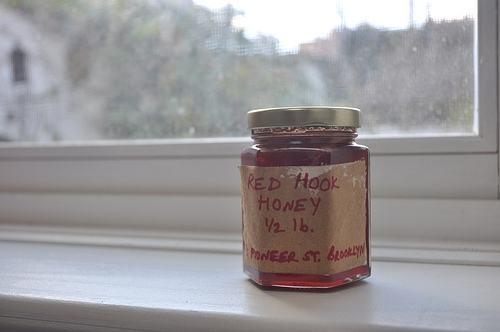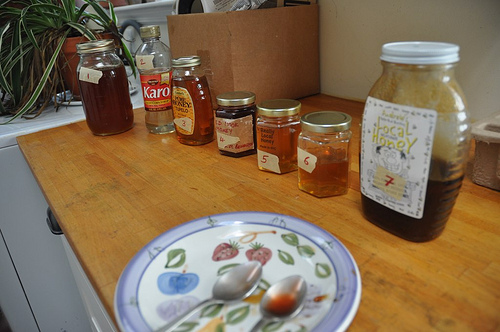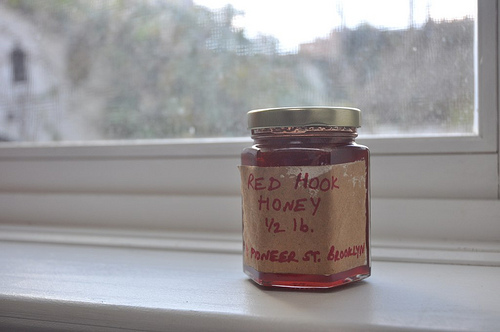 The red honey of Red Hook looks so pretty.Photo: Sarah GoodyearI was sitting in the kitchen of a man I had met just 15 minutes earlier. I had a blindfold over my eyes. And I was eating unidentified sweet, sticky substances from spoons that he handed me one by one, gently wrapping my fingers around the metal handles and guiding my hand so that I wouldn’t spill.
The red honey of Red Hook looks so pretty.Photo: Sarah GoodyearI was sitting in the kitchen of a man I had met just 15 minutes earlier. I had a blindfold over my eyes. And I was eating unidentified sweet, sticky substances from spoons that he handed me one by one, gently wrapping my fingers around the metal handles and guiding my hand so that I wouldn’t spill.
I love my job.
The man was Yeshwant Chitalkar, and I actually had encountered him online for the first time a couple of days earlier. He had shown up in the comments section of a story I wrote about bees in Brooklyn stained red by eating maraschino cherry syrup from a nearby factory.
Chitalkar, a soft-spoken man who has been keeping bees in Brooklyn’s Red Hook neighborhood for two years, wondered in his comment whether I had tasted the honey in question, which I had characterized as tasting “terrible” based on other reports I had read. I admitted I hadn’t.
When I contacted Chitalkar by email, he very graciously offered to let me taste the honey from his hives, which were among many in the area to come up red this season. The source of the mysterious coloration was ultimately traced to Dell’s Maraschino Cherries, a neighborhood business that’s been around since 1948. They marinate their product in corn syrup colored with Red Dye #40. The bees of Brooklyn went wild for it this year.
“I was pretty dejected,” Chitalkar told me. “The bees looked like vampires.”
Still, he went ahead and harvested the honey in his hives, which was actually a mix of wildflower honey from earlier in the season and syrup processed by the bees later in the year, after they had discovered the cherry factory in their tireless search for forage with a high sugar content.
So what does it taste like? Chitalkar suggested that we do a blind taste test that would include his honey as well as several other varieties.
When I showed up at his place on a quiet Sunday morning, I was a little bit nervous, I’ll admit. Not about sitting blindfolded and eating honey with a man I had just met. But about whether my palate would be refined enough to discern the difference between honey tainted with corn syrup and artificial coloring and the good stuff.
I sampled seven sweet spoonfuls altogether. And it turns out I have a pretty decent sense of taste.
Of the samples Chitalkar gave me, my favorite was #5 — which I wrote in my notes was “floral, light, complex, very pleasant.” Turns out that was from the hives of Jim Fischer, Chitalkar’s beekeeping mentor, whose bees on the Upper East Side of Manhattan have access to the nectar-rich urban paradise of Central Park. I found #3, which was revealed as a commercial Tupelo honey from the supermarket, to be “bright, floral, pleasant but not too complex.” I was able to detect a dark, nutty quality in #7, a buckwheat honey from Connecticut.
 Seven steps to a sugar high.Photo: Sarah GoodyearBut a few samples jumped out at me as being less delicious than the others. Sample #2 tasted incredibly bland and flat, completely devoid of the complexity of honey. No surprise there — Chitalkar had sneaked in a spoonful of Karo corn syrup, just to keep me on my toes. I wasn’t crazy about #6, a honey from Queens that struck me as “slightly metallic.”
Seven steps to a sugar high.Photo: Sarah GoodyearBut a few samples jumped out at me as being less delicious than the others. Sample #2 tasted incredibly bland and flat, completely devoid of the complexity of honey. No surprise there — Chitalkar had sneaked in a spoonful of Karo corn syrup, just to keep me on my toes. I wasn’t crazy about #6, a honey from Queens that struck me as “slightly metallic.”
Then there was #4. In my notes I said it had a “slightly off taste, musty, bitter.” That was the red honey of Red Hook, from Chitalkar’s hives.
To be fair, the floral notes of good local honey were also present. It was not “terrible,” by any means. But it’s clear to me after our experiment that even if the maraschino cherry syrup lends a lovely warm hue, something about the stuff — whether it’s the corn syrup or the artificial coloring — results in a noticeable difference in quality.
At the end of the tasting, I was fairly vibrating from the massive dose of sugar I had just consumed. Before I left, Chitalkar let me poke my head up through the hatch on his roof so I could see his hives, dormant for the winter, and the homespun green roof he had created to surround them. As I looked at the now-quiet scene, buffeted by the breezes of December, I had one wish for next summer: that the combined efforts of beekeepers and Dell’s Maraschino Cherries can keep the bees away from the red sticky syrup, and that next year’s Red Hook honey harvest will be pure gold.




